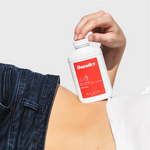Before the invention of deodorants, body smell was an issue that affected many people through the centuries. The ancient Egyptians were some of the first to wear perfume, while Mesopotamians used herbs and incense to mask their odor. The Egyptians also used wax cones that melted and released a fragrance. The invention of perfume helped to cover body odor, and it quickly became the main differentiator between deodorants today.
Until the 1930s, the only deodorants available to men were meant for women. In the early 1900s, the first deodorants were made for women, and they often left a greasy residue on clothing. By the 1930s, the first men's deodorants appeared, which were designed to be applied on the underarms and other areas where sweat was produced. As the popularity of these products grew, advertisements targeted male body odor negatively.
In Asia, mineral salts were used to counter the body odor. These salts were effective at killing bacteria and preventing bad smells caused by sweating. In the United States, the first commercial deodorant was called Mum, which used zinc oxide as a deodorant. In the 1950s, roll-on deodorants became a popular product.
Before the invention of deodorants, body smell was a problem that affected many people. It was common for people to wash themselves often in order to avoid body odor. Perfume and other antiperspirants were also used to mask body odor. In addition, people often wore dress shields to protect their clothing from perspiration.
The ancient Egyptians didn't have deodorant, but they used perfume oil liberally on their underarms and other parts of their body. They also took frequent baths and applied scented oils. The Egyptians also shaved their underarms to limit the growth of bacteria in their armpit area.
The first trademarked deodorant
The first trademarked deodorant dates back to 1888. Mum was an underarm paste that was applied liberally to the underarm area and was patented by an unknown Philadelphia inventor. This paste worked by killing bacteria, but the problem was that it took a long time to dry. It was also highly irritating and tended to pass through clothing. Then came Everdry, a solution of aluminum chloride that was applied with a cotton swab.
In the late 1940s, Helen Barnett Diserens joined the Mum production team. A suggestion by a colleague inspired Helen to develop an underarm deodorant based on the same principle as a newfangled invention called the ballpoint pen. This new type of deodorant applicator was tested in the USA in 1952 and marketed under the name of Ban Roll-On.
In the mid-1950s, mum was replaced by Everdry. In the following years, a roll-on deodorant was developed and eventually launched as an aerosol (Right Guard). It wasn't an overnight success, but sales were staggering.
Today, deodorants are an important part of personal hygiene regimens. Unlike a few decades ago, the technology behind them has improved dramatically over the years.
What was the first roll on deodorant applicator?
There are several different ways to apply deodorant. Roll-ons are one of the most common. Originally, deodorants were applied using fingertip application. However, as the demand for deodorants rose, roll-ons became more common. The roll-on deodorant applicator came into existence in 1952.
The roll-on deodorant applicator consists of three basic components: a plastic receptacle, a roll cage, and a sealing cap. The applicator ball is held in the roll cage. The cap is made of plastic and can be heat-sealed.
In the 1970s, the deodorant stick applicator became popular. It remains the most common type of deodorant used today.
The history of odor and sweat reveals that different cultures have tried to combat the problem. Over the years, there have been many chemicals used to prevent sweat and odor.
The First Antiperspirant
The first antiperspirant was developed in the late 19th century. It was called Odo-Ro-No and was developed by a Cincinnati surgeon. His daughter, Edna, tested it under her armpits to see if it worked. The product was a success and was marketed to women. A few years later, the first roll-on antiperspirant was created and marketed.
In 1903, Everdry patented the first antiperspirant. The active ingredient in early antiperspirants was aluminum chloride. This compound was suspended in an acid to be effective.
Early antiperspirants contained aluminum chloride, which was designed to block sweating pores. However, the solution was very irritating to skin and clothing. It was also red in color and had a tendency to stain clothing. This led to a plethora of complaints. Early antiperspirants had the potential to ruin clothing and even ruin people's shaved arms.
Early commercial deodorants were not a popular option for men.
As the era of modernization accelerated, the need for products that could effectively prevent body odor increased. The nineteenth century saw the introduction of perfumes and scented soap. These products were marketed to the masses by clever marketing.



